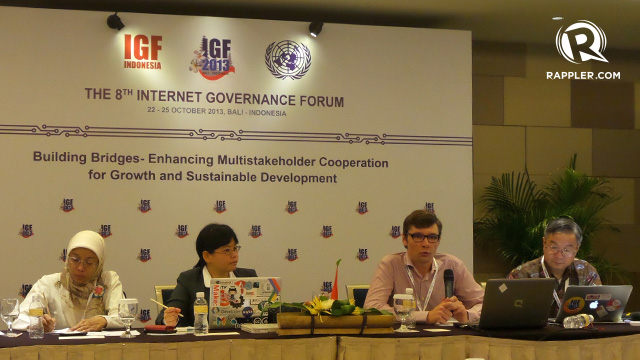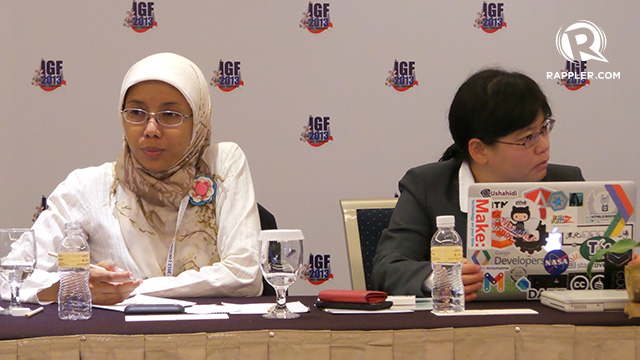SUMMARY
This is AI generated summarization, which may have errors. For context, always refer to the full article.

BALI, Indonesia – It took one tweet to collect 6,000 rice bowls for survivors of the 2010 eruption of Mount Merapi in Indonesia. This is how technology has helped save lives.
Civil society groups, technology companies, and Internet enthusiasts discussed during the Internet Governance Forum (IGF) here how to maximize the use of the Internet in times of disaster.
At the workshop on “Power of Internet for disaster and environmental control,” Ambar Sari Dewi of the Indonesian civil society group Jalin Merapi and Google’s Fumi Yamazaki described best practices on the use of the Internet during the eruption of Mount Merapi and the 2011 Japan earthquake and tsunami.
It was one of the first workshops held on Day 1 of the IGF on Tuesday, October 22.
The two women shared lessons on using the Internet and social media in times of disaster for both developed and developing nations:
1. Use all available technology. Don’t rely on the Internet alone.
Ambar Sari Dewi said that Jalin Merapi uses 14 types of information and communication technology media and devices. The group uses these to get in touch with volunteers, police, military, rescue teams, victims, aid agencies, journalists, and the public.
Established in 2006, Jalin Merapi is an information network founded by 3 community radios in the slope of Mount Merapi. It did disaster response during the 2010 eruption of Mount Merapi that killed about 200 people.
The14 types of ICT the group uses include two-way communication radio, SMS, telephone, and Twitter.
“We have 14 types of ICT because we strongly believe it is not enough to rely on one type of technology so we need convergence because every type has its advantages and disadvantages,” said Ambar Sari Dewi.
“In our experience, the middle lower class uses Facebook more than Twitter. They think Twitter is more complex, hard to understand. On Facebook, they can upload photo more easily, just type a status.”
She said for areas without Internet access, two-way radios and SMS are the most reliable devices.
Ambar Sari Dewi said infrastructure for the Internet is not yet fully developed but the web’s power should not be underestimated. She stressed that it is crucial to link the different types of ICT to maximize this power.
“We had one night when there were 6,000 survivors moving from the peak of Merapi to the shelter and they haven’t eaten for a day, they have to eat. There were 6,000 people and they needed food immediately and one of our volunteers called HQ and they asked me how to find 6,000 rice bowls. We tweeted it and in just one hour, we collected 6,000 food for survivors,” she said.
2. Visualize, analyze data. They will point to where help is needed.

Fumi Yamazaki, developer advocate at Google, also discussed the power of converging online and offline efforts when Google launched its Person Finder in the wake of the Japan quake and tsunami.
“One thing we learned is in places hit by disaster, people were not using the Internet. People wrote names of missing persons on walls and put it on paper, it was very analogue. We had to adjust to that reality and we had people in these areas take photos and upload it but the information wasn’t searchable.”
“People all around the world started transcribing and made it text-searchable. We were initially concerned but we thought we should just go for it. People started to discuss: ‘Does this read a or b?’ People started organically doing it. It’s important to trust people. It’s incredible!”
Yamazaki also stressed the importance of visualizing data to come out with useful information.
“We have a map that can overlay gasoline information, shelter information, hospital information, overlaying various data in one shot.”
Yamazaki discussed Project 311, the Great East Japan Earthquake Big Data Project, which collates and analyzes big data from various sources of information.
“We may not know where the people are but we can find out where the mobile phones are and try to use that data to help find people,” she said.
She said the data sources were as diverse as road data, railroad operation information, real-time population information, newspaper articles, transcripts of audio broadcasts of NHK, and tweets.
3. Improve international cooperation. No one government can deal with large-scale disasters.
Beyond national efforts, there is need for greater international cooperation to respond to “catastrophic disasters” of great scales, said moderator Izumi Aizu of Japan’s Tama University and delegates who joined the workshop.
A delegate cited the problem with the 2007 Cyclone Nargis in Myanmar when the government did not allow aid groups into the country.
Izumi Aisu said the international community must look into setting up a mechanism to address this.
“I’d like to see more concrete efforts to talk to each other, set up some framework beyond intergovernmental cooperation. Large-scale disasters are so bad that no one government can really deal with it. You need real people power to help the victims,” Aisu said. – Rappler.com
Add a comment
How does this make you feel?
There are no comments yet. Add your comment to start the conversation.